Module 2 Unit 6 Seasona changes 课件
文档属性
| 名称 | Module 2 Unit 6 Seasona changes 课件 | 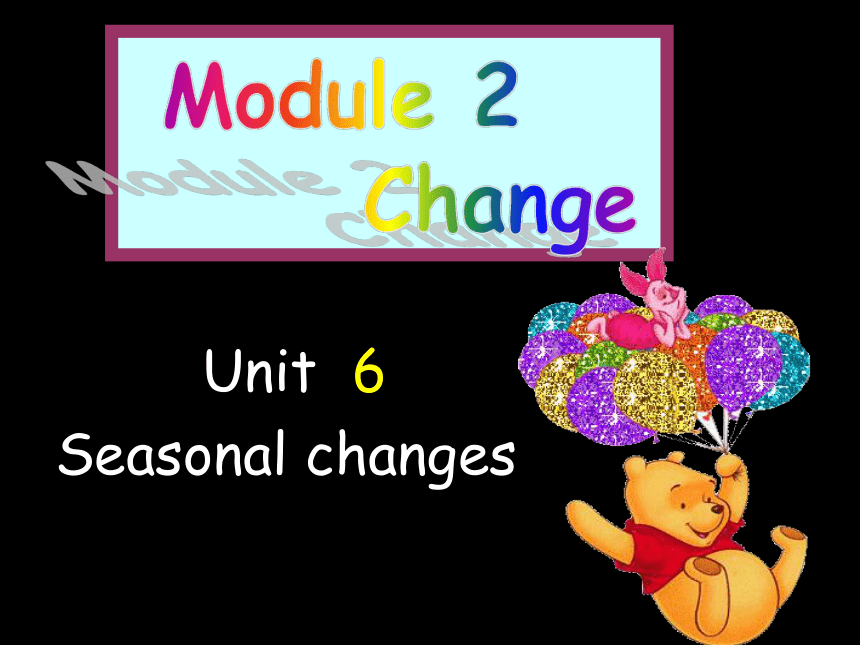 | |
| 格式 | zip | ||
| 文件大小 | 1.7MB | ||
| 资源类型 | 教案 | ||
| 版本资源 | 牛津上海版(试用本) | ||
| 科目 | 英语 | ||
| 更新时间 | 2020-06-12 16:23:42 | ||
图片预览


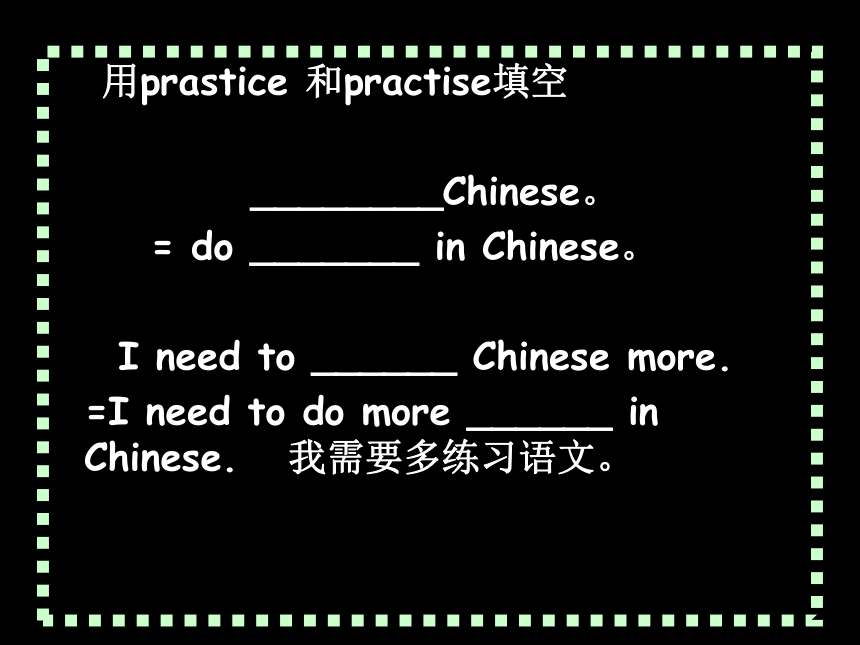
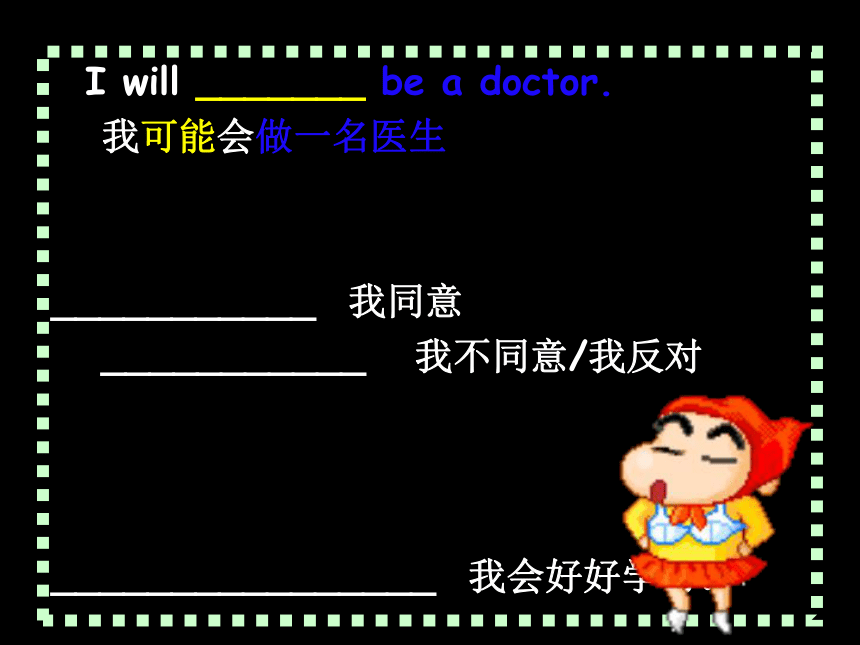
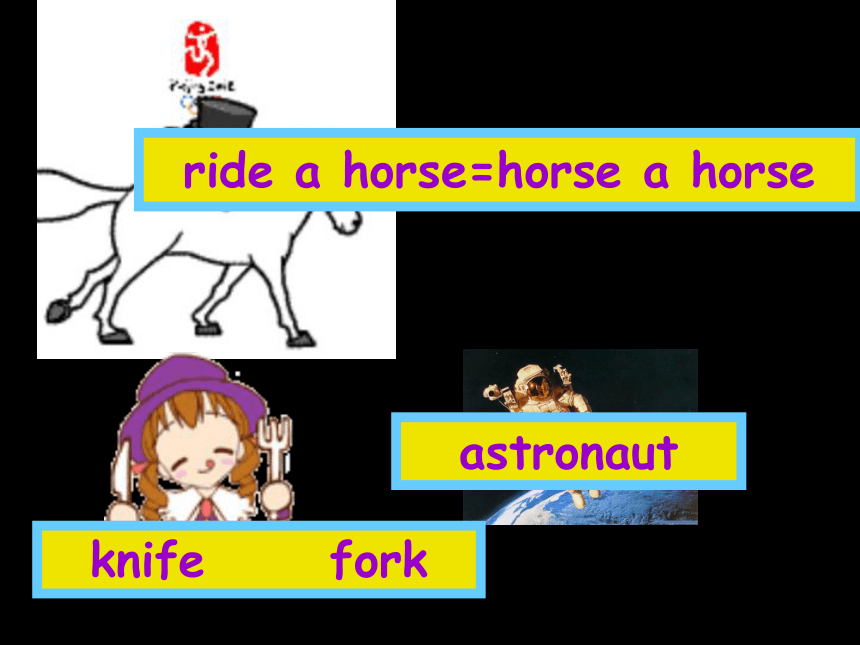
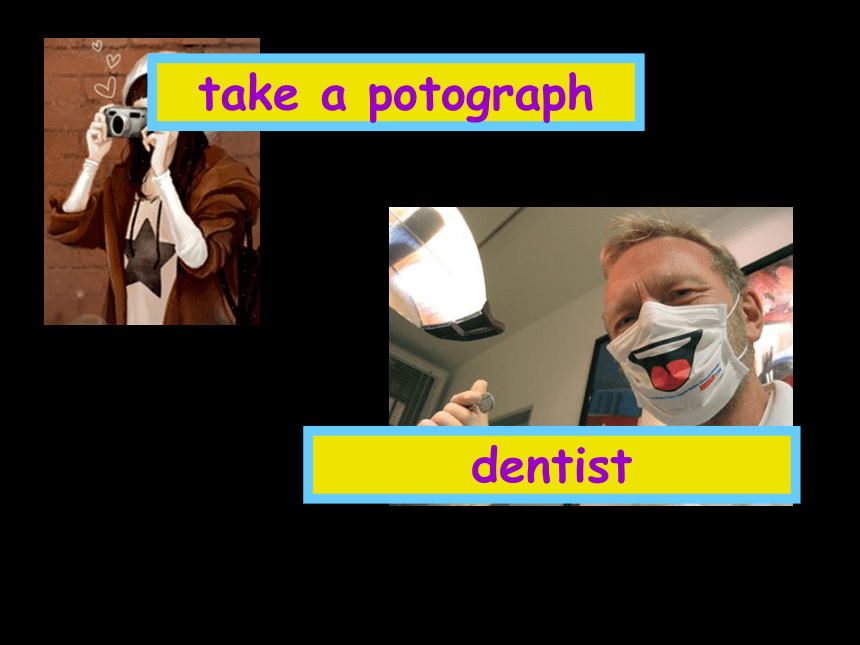
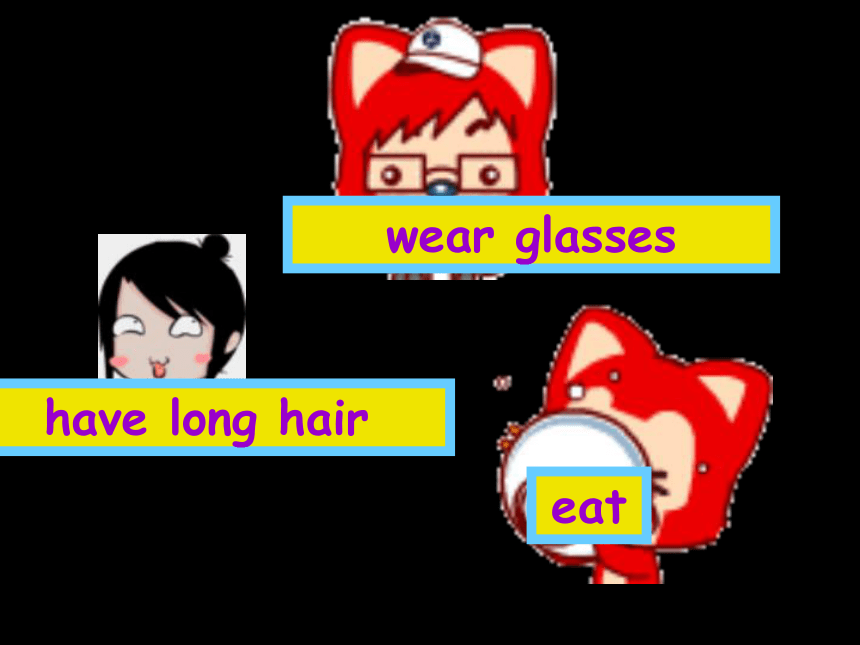
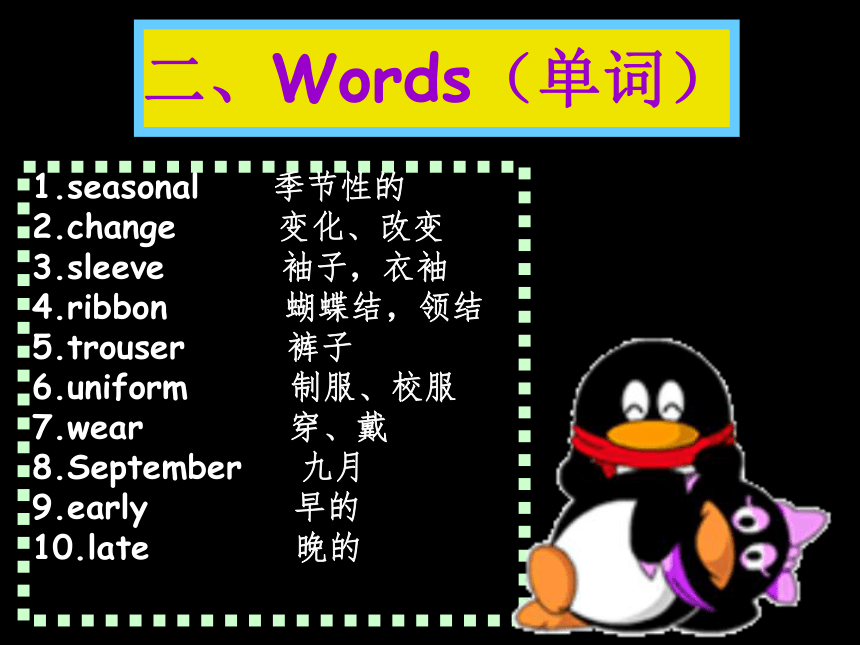
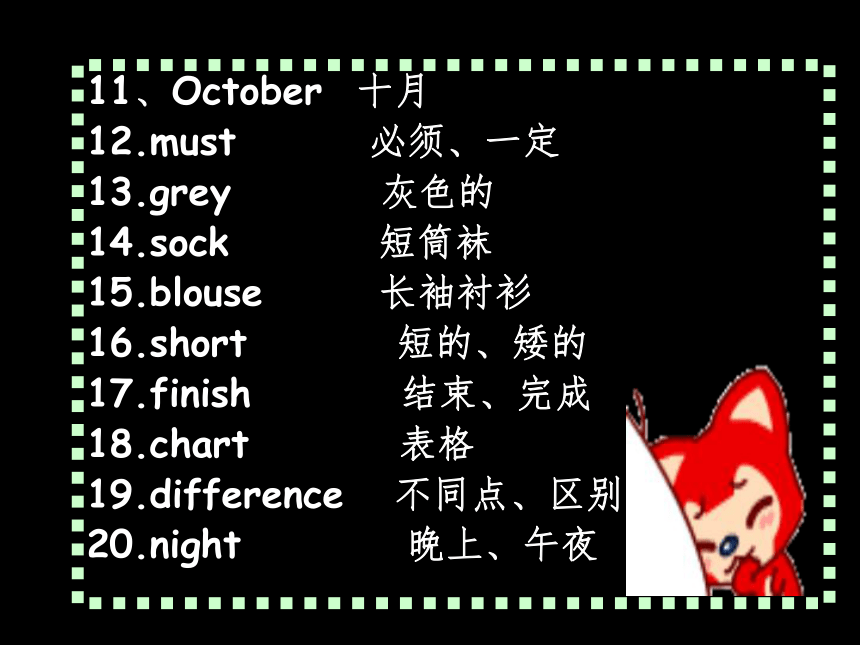

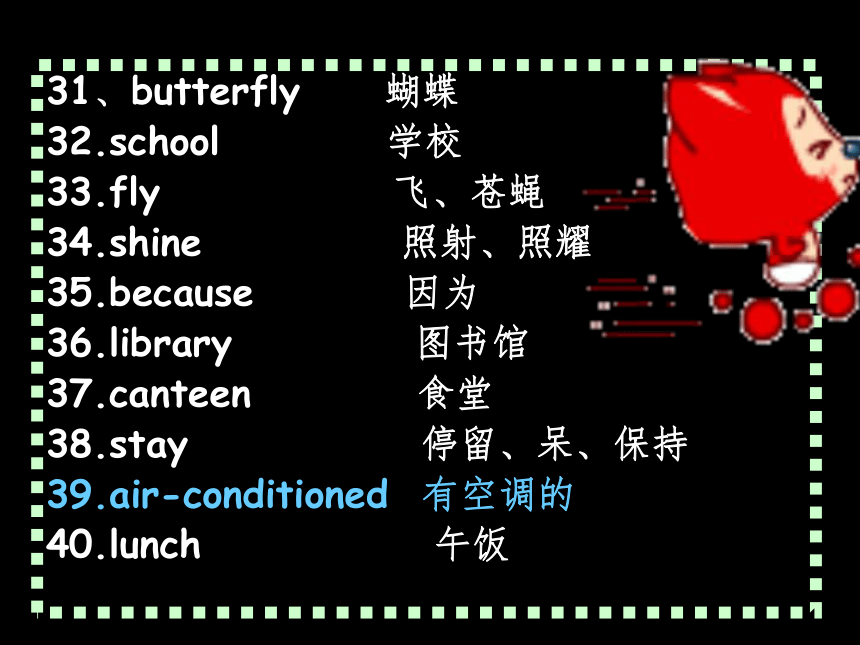
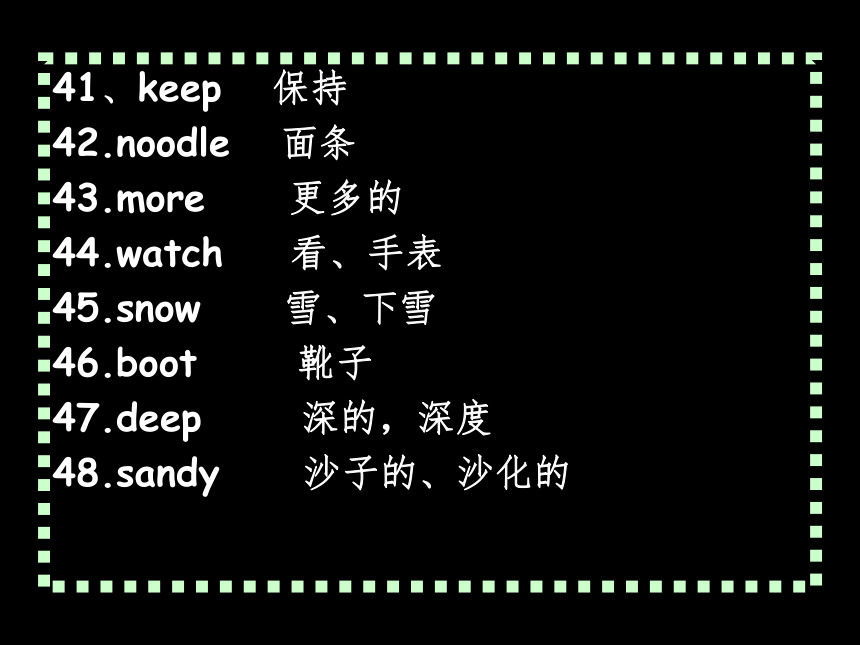
文档简介
课件36张PPT。 Unit 6
Seasonal changesModule 2
Change Revision(复习) 用prastice 和practise填空
________Chinese。
= do _______ in Chinese。
I need to ______ Chinese more.
=I need to do more ______ in Chinese. 我需要多练习语文。 I will _______ be a doctor.
我可能会做一名医生
___________ 我同意
___________ 我不同意/我反对
________________ 我会好好学习。
ride a horse=horse a horseastronautknife forktake a potographdentisthave long hair wear glasses eat 二、Words(单词)1.seasonal 季节性的
2.change 变化、改变
3.sleeve 袖子,衣袖
4.ribbon 蝴蝶结,领结
5.trouser 裤子
6.uniform 制服、校服
7.wear 穿、戴
8.September 九月
9.early 早的
10.late 晚的11、October 十月
12.must 必须、一定
13.grey 灰色的
14.sock 短筒袜
15.blouse 长袖衬衫
16.short 短的、矮的
17.finish 结束、完成
18.chart 表格
19.difference 不同点、区别
20.night 晚上、午夜
21.dark 暗的、无光的
22.until 直到
23.start 开始
24.before 。。。之前
25.half 一半
26.reporter 记者
27.magazine 杂志
28.life-lives 生命
29.garden 花园
30.plenty 大量的,许多31、butterfly 蝴蝶
32.school 学校
33.fly 飞、苍蝇
34.shine 照射、照耀
35.because 因为
36.library 图书馆
37.canteen 食堂
38.stay 停留、呆、保持
39.air-conditioned 有空调的
40.lunch 午饭41、keep 保持
42.noodle 面条
43.more 更多的
44.watch 看、手表
45.snow 雪、下雪
46.boot 靴子
47.deep 深的,深度
48.sandy 沙子的、沙化的三、Phrases and sentences. (短语及句子)1、wear a dress 穿裙子
wear glasses 戴眼镜
wear scarves 戴围巾
2.in+月份、年/季节
on+日期/星期几
at+时间3.must 必须、一定
need 需要
have to 不得不
以上三个后面都直接加动词原形,叫做情态动词
4.grey blouse with white sleeves
有白色袖子灰色的长袖衬衫
5.in the evening 在晚上
at night 在晚上
in the morning 在早上
in the afternoon 在午间、在中午6.look at sth/sb 看sth/sb
watch TV 看电视
see a film 看电影
7.形容词的比较级/最高级:
结尾是y的、把y变i加er/est.
多音节词前面加more/most.
规则变化直接加er/est.
一元一辅结尾的双写尾字母加er/est.8.get dark
变暗、天黑
9.It will not be dark until half past six.
直到六点天才会黑。
10.The days start before/after six o’clock.
昼开始在六点之前/后。
11.plenty of
大量的、许多。
There are plenty of flowers in the garden. 花园里有许多花。12.一般将来时
构成:主语+will(not)+do sth
主语+be(not) going to+do sth
标志词:tomorrow,next week,in 15 years’time。
现在进行时构成: be+动词ing
一般现在是构成:主语+动词
当主语为男他,女她,动物它时,动词要用单三形式。其他用原形。13.Not many students like playing football in the playground,because it’s very hot.
不是许多学生喜欢在操场玩足球,因为太热了。
14.More students like having noodles for lunch/supper/breakfast.
更多的学生喜欢午餐/晚餐/早餐吃面条。15.stay in the library
呆在图书馆
16.after school
放学之后、下课之后
17.Wearing more clothes helps us to keep warm.
穿更多的衣服帮助我们保暖。
18.all over the world
全世界
19.a pair of trousers
一条裤子20.see sb +动词ing形式
看见sb做。。
21.before/after
在。。之前/之后
22.early October 十月上旬
Late September 九月下旬
23.by the sea 在海边
on the beach 在沙滩24.snow 名词:雪 、动词:下雪
例句:It‘s snowing outside。
The snow is white。
25.difference 区别,不同点。
当翻译为’有不同点‘时、为可数名词。
当翻译为’无不同点‘时、为不可数名词。
例句:There are a few differences between the two people。
There is no difference among these children。
26.一般过去时
是英语语法的一种,表示过去某个时间里发生的动作或状态。一般过去式的动词通常用动词的过去式形式来表示,而动词的过去式是在动词原形的基础上变化的。动词的过去式可分为规则动词和不规则动词。
【过去式】
1、过去发生的而现在已经结束的动作要用一般过去式来表示。
2、表示过去某个时间里发生的动作或状态。
3、过去习惯性、经常性的动作、行为;过去主语所具备的能力和性格。
【过去时态】表示行为、动作和状态在各种时间条件下的动词形式。
【过去时态结构】指的是过去时态下的动词形式的语法构成。
过去式就是动词的变化,表示过去发生的事。一般看到ago,before, in 几几年,就是过去式。
work-worked
listen-listened 一般的就是直接加ed,特殊的就有一些变化。构成
表示一般过去式的动词通常用动词的过去式形式来表示,而动词的过去式是在动词原形的基础上变化的。动词的过去式可分为规则动词和不规则动词。规则动词的过去式变化如下:
(1)一般情况下,动词词尾加 ed ,如:
work—worked; play—played;want— wanted; act—acted
(2)以不发音的 e 结尾动词,动词词尾加 d,如:
live—lived; move—moved; decide—decided; decline—declined; hope—hoped;
(3)以辅音字母 + y结尾的动词,把y变为i 再加ed,如:
studied tried copied justified cried carried embodied emptied
(4)以一个辅音字母结尾的重读闭音节动词,双写词尾辅音字母,再加 ed,如:
stopped begged fretted dragged dropped planned dotted dripped
(5)注:不规则动词的过去式变化规律性不强,须多加记忆。
go - went,make - made,get - got ,buy - bought ,come - came ,fly-flew ,is/am-was,are-were ,see-saw ,bring-brought,do-did,teach-taught, think-thought, say-said,sit-sat. read-read, spend-spent, eat-ate,give-gave,sit-sat,tell-told,write-wrote,feel-felt,find-found,hear-heard,know-knew,
put-put,grow-grew,take-took,catch-caught,come-came,become-became,swim-swam,sweep—swept,sing—sang,draw—drew,
以上的(1)至(4)条中的发音均有改变,具体分别有/d/ /t/ /id/。
而不规则动词的过去式的发音则略有不同,但是有些还是按照一定规律变化的。如以上的:make - made,get - got ,buy - bought ,come - came ,fly-flew ,bring-brought,teach-taught, think-thought, say-said,sit-sat. read-read, spend-spent,give-gave,tell-told,write-wrote,feel-felt,find-found,hear-heard,know-knew,put-put,grow-grew,take-took,catch-caught,come-came,become-became,swim-swam,sweep—swept,sing—sang,draw—drew。
一般过去时的用法
一.概念:一般过去时是表示在过去的时间里发生的动作或状态,通常与表示过去的时间状语连用。
二.时间状语:yesterday, the day before yesterday, two days ago, long long ago,a minute ago,last year(week, month), just now, at that time, in those days.
三.过去时的用法:1.有确定的过去时间状语时要用过去式。
例:We had a good time last week.
2.表示过去连续发生的动作时,要用过去式。
例:The boy closed the door, turned off the window, and then went to bed.
3. 表示过去一段时间内经常或反复的动作,要用过去式。
例:She often came to help me at that time.
四.一般过去式的构成形式:☆Be动词的过去式: (1)肯定句:主语+ be动词的过去式(was, were)
例:He was ill yesterday. She was nine two years ago.They were my students long long ago.
(2)否定句:主语+ be动词的过去式(was, were)+ not
例:He was not ill yesterday.She was not nine two years ago.They were not my students long long ago.
(3)一般疑问句:直接把be动词提到句首。
例:Was he ill yesterday?
肯定回答:Yes, he was.
否定回答:No, he wasn't.Was she nine two years ago? Yes, she was. / No, she wasn't.Were they your students long long ago? Yes, they were. / No, they weren't.
☆实意动词的过去式:(1)肯定句:主语+动词的过去式
例:He played football last week.She watched TV last night.
(2)否定句:主语+ did not +动词原形
例:He did not play football last week.She didn’t watch TV last night.
(3)一般疑问句:Did +主语+动词原形 例:Did he play football last week?
回答:Yes, he did./ No, he didn't.
Did she watch TV last night?
回答:Yes, she did. / No, she didn’t.
动词变过去式的几种常用规则:1.一般动词直接+ ed;
例:look--looked want--wanted listen --listened
2.以e结尾的词直接+ d;例:live--lived phone--phoned
3.以辅音字母加y结尾, 变y为i加ed;例:try--tried study--studied
4.重读闭音节结尾的,词尾只有一个辅音字母,双写词尾辅音字母+ ed;例:stop--stopped plan--planned
5.不规则动词: 动词由原形转变为过去式时不按词尾加“-ed”之变化规则者叫做不规则动词。小学常见的动词不规则过去式如:是is/am- was, 是are- were, 来come-came, 去go- went, 有have- had, 做/干do- did, 做make- made 读read- read, 放put- put, 切割cut- cut,写write- wrote, 带走take- took, 买buy- bought, 带来bring- brought,想think- thought, 看见see- saw, 说say- said, 说话speak- spoke,打破break- broke, 得到get- got, 跑run- ran, 告诉tell- told,唱sing- sang, 喝drink- drank, 吃eat- ate, 游泳swim- swam,开始begin- began, 偷steal- stole, 遇见meet- met, 卖sell- sold, 坐sit- sat,跑run-ran,读read-read,想want-want,等等 Be 动词的一般过去时态
在没有实义动词的句子中使用be动词, am is 的过去式为was; are的过去式为were.
构成:
肯定句:主语+was (were) +表语
如:I was late yesterday. (昨天我迟到了。)
否定句:主语+was (were) +not+表语
如:We weren't late yesterday. (我们昨天没迟到)
疑问句:Was (Were) +主语+表语
如: Do you sick yesterday? (你昨天病了吗?)
肯定回答: Yes, I was. (是的,我病了。)
否定回答: No, I wasn't. (不,我没病。)
特殊疑问句: 特殊疑问词+was (were) +主语+表语
如:When were you born? 你是什么时候出生的? 四。Revision(复习)A pair of trousers uniformreporterribbonWatch-watchesButterfly-butterfliesA pair of bootssandy Thank you ``` ~ See you ```
Seasonal changesModule 2
Change Revision(复习) 用prastice 和practise填空
________Chinese。
= do _______ in Chinese。
I need to ______ Chinese more.
=I need to do more ______ in Chinese. 我需要多练习语文。 I will _______ be a doctor.
我可能会做一名医生
___________ 我同意
___________ 我不同意/我反对
________________ 我会好好学习。
ride a horse=horse a horseastronautknife forktake a potographdentisthave long hair wear glasses eat 二、Words(单词)1.seasonal 季节性的
2.change 变化、改变
3.sleeve 袖子,衣袖
4.ribbon 蝴蝶结,领结
5.trouser 裤子
6.uniform 制服、校服
7.wear 穿、戴
8.September 九月
9.early 早的
10.late 晚的11、October 十月
12.must 必须、一定
13.grey 灰色的
14.sock 短筒袜
15.blouse 长袖衬衫
16.short 短的、矮的
17.finish 结束、完成
18.chart 表格
19.difference 不同点、区别
20.night 晚上、午夜
21.dark 暗的、无光的
22.until 直到
23.start 开始
24.before 。。。之前
25.half 一半
26.reporter 记者
27.magazine 杂志
28.life-lives 生命
29.garden 花园
30.plenty 大量的,许多31、butterfly 蝴蝶
32.school 学校
33.fly 飞、苍蝇
34.shine 照射、照耀
35.because 因为
36.library 图书馆
37.canteen 食堂
38.stay 停留、呆、保持
39.air-conditioned 有空调的
40.lunch 午饭41、keep 保持
42.noodle 面条
43.more 更多的
44.watch 看、手表
45.snow 雪、下雪
46.boot 靴子
47.deep 深的,深度
48.sandy 沙子的、沙化的三、Phrases and sentences. (短语及句子)1、wear a dress 穿裙子
wear glasses 戴眼镜
wear scarves 戴围巾
2.in+月份、年/季节
on+日期/星期几
at+时间3.must 必须、一定
need 需要
have to 不得不
以上三个后面都直接加动词原形,叫做情态动词
4.grey blouse with white sleeves
有白色袖子灰色的长袖衬衫
5.in the evening 在晚上
at night 在晚上
in the morning 在早上
in the afternoon 在午间、在中午6.look at sth/sb 看sth/sb
watch TV 看电视
see a film 看电影
7.形容词的比较级/最高级:
结尾是y的、把y变i加er/est.
多音节词前面加more/most.
规则变化直接加er/est.
一元一辅结尾的双写尾字母加er/est.8.get dark
变暗、天黑
9.It will not be dark until half past six.
直到六点天才会黑。
10.The days start before/after six o’clock.
昼开始在六点之前/后。
11.plenty of
大量的、许多。
There are plenty of flowers in the garden. 花园里有许多花。12.一般将来时
构成:主语+will(not)+do sth
主语+be(not) going to+do sth
标志词:tomorrow,next week,in 15 years’time。
现在进行时构成: be+动词ing
一般现在是构成:主语+动词
当主语为男他,女她,动物它时,动词要用单三形式。其他用原形。13.Not many students like playing football in the playground,because it’s very hot.
不是许多学生喜欢在操场玩足球,因为太热了。
14.More students like having noodles for lunch/supper/breakfast.
更多的学生喜欢午餐/晚餐/早餐吃面条。15.stay in the library
呆在图书馆
16.after school
放学之后、下课之后
17.Wearing more clothes helps us to keep warm.
穿更多的衣服帮助我们保暖。
18.all over the world
全世界
19.a pair of trousers
一条裤子20.see sb +动词ing形式
看见sb做。。
21.before/after
在。。之前/之后
22.early October 十月上旬
Late September 九月下旬
23.by the sea 在海边
on the beach 在沙滩24.snow 名词:雪 、动词:下雪
例句:It‘s snowing outside。
The snow is white。
25.difference 区别,不同点。
当翻译为’有不同点‘时、为可数名词。
当翻译为’无不同点‘时、为不可数名词。
例句:There are a few differences between the two people。
There is no difference among these children。
26.一般过去时
是英语语法的一种,表示过去某个时间里发生的动作或状态。一般过去式的动词通常用动词的过去式形式来表示,而动词的过去式是在动词原形的基础上变化的。动词的过去式可分为规则动词和不规则动词。
【过去式】
1、过去发生的而现在已经结束的动作要用一般过去式来表示。
2、表示过去某个时间里发生的动作或状态。
3、过去习惯性、经常性的动作、行为;过去主语所具备的能力和性格。
【过去时态】表示行为、动作和状态在各种时间条件下的动词形式。
【过去时态结构】指的是过去时态下的动词形式的语法构成。
过去式就是动词的变化,表示过去发生的事。一般看到ago,before, in 几几年,就是过去式。
work-worked
listen-listened 一般的就是直接加ed,特殊的就有一些变化。构成
表示一般过去式的动词通常用动词的过去式形式来表示,而动词的过去式是在动词原形的基础上变化的。动词的过去式可分为规则动词和不规则动词。规则动词的过去式变化如下:
(1)一般情况下,动词词尾加 ed ,如:
work—worked; play—played;want— wanted; act—acted
(2)以不发音的 e 结尾动词,动词词尾加 d,如:
live—lived; move—moved; decide—decided; decline—declined; hope—hoped;
(3)以辅音字母 + y结尾的动词,把y变为i 再加ed,如:
studied tried copied justified cried carried embodied emptied
(4)以一个辅音字母结尾的重读闭音节动词,双写词尾辅音字母,再加 ed,如:
stopped begged fretted dragged dropped planned dotted dripped
(5)注:不规则动词的过去式变化规律性不强,须多加记忆。
go - went,make - made,get - got ,buy - bought ,come - came ,fly-flew ,is/am-was,are-were ,see-saw ,bring-brought,do-did,teach-taught, think-thought, say-said,sit-sat. read-read, spend-spent, eat-ate,give-gave,sit-sat,tell-told,write-wrote,feel-felt,find-found,hear-heard,know-knew,
put-put,grow-grew,take-took,catch-caught,come-came,become-became,swim-swam,sweep—swept,sing—sang,draw—drew,
以上的(1)至(4)条中的发音均有改变,具体分别有/d/ /t/ /id/。
而不规则动词的过去式的发音则略有不同,但是有些还是按照一定规律变化的。如以上的:make - made,get - got ,buy - bought ,come - came ,fly-flew ,bring-brought,teach-taught, think-thought, say-said,sit-sat. read-read, spend-spent,give-gave,tell-told,write-wrote,feel-felt,find-found,hear-heard,know-knew,put-put,grow-grew,take-took,catch-caught,come-came,become-became,swim-swam,sweep—swept,sing—sang,draw—drew。
一般过去时的用法
一.概念:一般过去时是表示在过去的时间里发生的动作或状态,通常与表示过去的时间状语连用。
二.时间状语:yesterday, the day before yesterday, two days ago, long long ago,a minute ago,last year(week, month), just now, at that time, in those days.
三.过去时的用法:1.有确定的过去时间状语时要用过去式。
例:We had a good time last week.
2.表示过去连续发生的动作时,要用过去式。
例:The boy closed the door, turned off the window, and then went to bed.
3. 表示过去一段时间内经常或反复的动作,要用过去式。
例:She often came to help me at that time.
四.一般过去式的构成形式:☆Be动词的过去式: (1)肯定句:主语+ be动词的过去式(was, were)
例:He was ill yesterday. She was nine two years ago.They were my students long long ago.
(2)否定句:主语+ be动词的过去式(was, were)+ not
例:He was not ill yesterday.She was not nine two years ago.They were not my students long long ago.
(3)一般疑问句:直接把be动词提到句首。
例:Was he ill yesterday?
肯定回答:Yes, he was.
否定回答:No, he wasn't.Was she nine two years ago? Yes, she was. / No, she wasn't.Were they your students long long ago? Yes, they were. / No, they weren't.
☆实意动词的过去式:(1)肯定句:主语+动词的过去式
例:He played football last week.She watched TV last night.
(2)否定句:主语+ did not +动词原形
例:He did not play football last week.She didn’t watch TV last night.
(3)一般疑问句:Did +主语+动词原形 例:Did he play football last week?
回答:Yes, he did./ No, he didn't.
Did she watch TV last night?
回答:Yes, she did. / No, she didn’t.
动词变过去式的几种常用规则:1.一般动词直接+ ed;
例:look--looked want--wanted listen --listened
2.以e结尾的词直接+ d;例:live--lived phone--phoned
3.以辅音字母加y结尾, 变y为i加ed;例:try--tried study--studied
4.重读闭音节结尾的,词尾只有一个辅音字母,双写词尾辅音字母+ ed;例:stop--stopped plan--planned
5.不规则动词: 动词由原形转变为过去式时不按词尾加“-ed”之变化规则者叫做不规则动词。小学常见的动词不规则过去式如:是is/am- was, 是are- were, 来come-came, 去go- went, 有have- had, 做/干do- did, 做make- made 读read- read, 放put- put, 切割cut- cut,写write- wrote, 带走take- took, 买buy- bought, 带来bring- brought,想think- thought, 看见see- saw, 说say- said, 说话speak- spoke,打破break- broke, 得到get- got, 跑run- ran, 告诉tell- told,唱sing- sang, 喝drink- drank, 吃eat- ate, 游泳swim- swam,开始begin- began, 偷steal- stole, 遇见meet- met, 卖sell- sold, 坐sit- sat,跑run-ran,读read-read,想want-want,等等 Be 动词的一般过去时态
在没有实义动词的句子中使用be动词, am is 的过去式为was; are的过去式为were.
构成:
肯定句:主语+was (were) +表语
如:I was late yesterday. (昨天我迟到了。)
否定句:主语+was (were) +not+表语
如:We weren't late yesterday. (我们昨天没迟到)
疑问句:Was (Were) +主语+表语
如: Do you sick yesterday? (你昨天病了吗?)
肯定回答: Yes, I was. (是的,我病了。)
否定回答: No, I wasn't. (不,我没病。)
特殊疑问句: 特殊疑问词+was (were) +主语+表语
如:When were you born? 你是什么时候出生的? 四。Revision(复习)A pair of trousers uniformreporterribbonWatch-watchesButterfly-butterfliesA pair of bootssandy Thank you ``` ~ See you ```
同课章节目录
- Module 1 City life
- Unit 1 Great cities in Asia
- Unit 2 At the airport
- Unit 3 Dragon Boat Festival
- Unit 4 Staying healthy
- Module 2 Changes
- Unit 5 What will I be like?
- Unit 6 Seasonal changes
- Unit 7 Travelling in Garden City
- Module 3 The nature world
- Unit 8 Windy weathe
- Unit 9 Sea water and rain wate
- Unit 10 Forests and land
- Unit 11 Controlling fire
